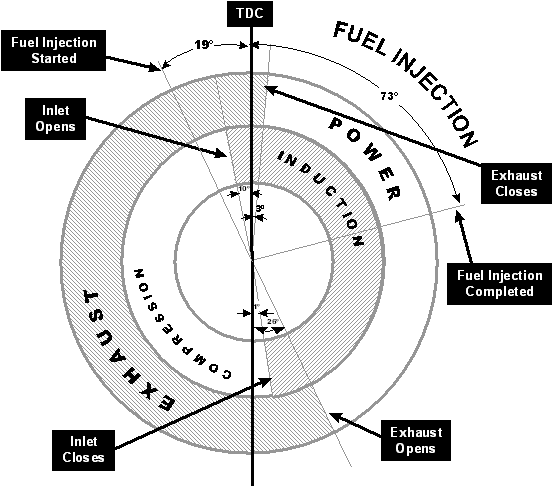

It was specifically targeted to boosted/inter-cooled engines.

#Valve timing diagram of 2 stroke engine pdf full
In the 1954 patent, the end-of-compression temperature was to decrease as load increased so that the engine could burn more fuel at full load while staying within the limits of the material properties. Miller’s motivation was to increase power density. He claimed his ideas for naturally aspirated and forced induction diesel and spark ignition. In two of his patents, he described variable intake valve timing mechanisms that allowed IVC to vary with engine load in order to control the in-cylinder temperature at the end of the compression stroke. Miller was primarily interested in using intake valve closing timing to limit TDC temperatures. This is evidenced by the fact that it was discussed in a 1927 report as an option to limit knock in aviation engines when using low octane fuels. Ralph Miller did not conceive of the idea of using valve timing to control effective compression ratio. The use of these terms in the literature is not consistent. Over-expanded cycles are commonly referred to as Miller or Atkinson cycles referring to the inventors Ralph Miller and James Atkinson. The lower temperature enables the use of higher geometric compression ratios that yield a longer expansion ratio and an efficiency benefit. The primary effect of EIVC and LIVC is a reduction in temperature at the end of the compression stroke. In modern practice, over-expanded cycles are implemented with either early (EIVC) or late (LIVC) intake valve closing. In spark-ignited engines, the benefits of the Miller cycle include reduced pumping losses at part load and improved efficiency, as well as knock mitigation.Įngine cycles in which the effective compression ratio is smaller than the effective expansion ratio (see compression ratio discussion under Engine Fundamentals) can be referred to as over-expanded cycles. In diesels, Miller cycle has been used primarily to control NOx emissions at high engine load. Miller cycle has been implemented in both diesel and spark-ignited engines. The Miller cycle is an over-expanded cycle implemented with either early (EIVC) or late (LIVC) intake valve closing. Abstract: Engine cycles in which the effective compression ratio is smaller than the effective expansion ratio are referred to as over-expanded cycles.


 0 kommentar(er)
0 kommentar(er)
